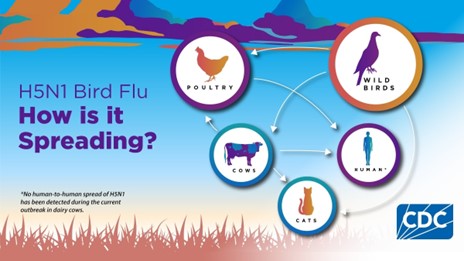Avian influenza (H5N1) commonly called bird flu, is a disease that is widespread across the US and world in aquatic birds and are causing outbreaks in poultry and dairy cows but can be transmitted to other animals including humans.1 On this campus, field researchers, poultry and dairy farm staff, veterinarians, wildlife clinicians and diagnostic lab staff are at a higher risk of encountering infected animals, materials and samples through their work.
How it's Spread
Wild aquatic birds are the primary reservoir (hosts) for avian influenza A viruses that are spreading to poultry, cattle, other mammals and in rare cases to people. Low Pathogenic Avian Influenza (LPAI) causes either mild or no symptoms of disease while High Pathogenic Avian Influenza (HPAI) causes severe disease and high mortality in animals.

Migratory birds spread the virus through their droppings, saliva and nasal secretions. As other animals come into contact with these materials, they can become infected. It’s important to not only keep workers safe from becoming infected, it’s also important to protect our herds, flocks and veterinary patients. The level of protection will depend on cases found or suspected. The majority of human cases have been from workers exposed to poultry and dairy cattle that were infected. There is no evidence of human-to-human transmission associated with the current HPAI cases, as of February 2025.2
Biosafety and Biosecurity
Because of this increased risk to field and laboratory researchers, veterinarians and farm personnel, biosafety and biosecurity practices should be reviewed and updated to reflect local risk of exposure to animals or materials that could be infected with HPAI. Plans should include a hierarchy of controls that consider site-specific risks.3 As the level of potential exposure increases, additional layers of engineering controls, administrative controls and personal protective equipment (PPE) should be implemented.3 It is important to handle samples suspected of containing avian influenza at Biosafety Level 2 and use a biosafety cabinet whenever possible. If performing surveillance sampling in the field, consider additional PPE like goggles, full face protection or respiratory protection (N95s). Although the seasonal influenza vaccine will not prevent avian influenza, it can reduce the likelihood of being coinfected so consider getting vaccinated.4
It's also important to prevent inadvertently contaminating a herd or flock. Since the virus can be carried on boots or clothing, consider biosecurity practices that reduce potential exposure, e.g. foot coverings or foot baths at entry locations. Always wash hands after removing PPE. Consider implementing isolation/quarantine practices and establishing traffic patterns and wait periods when moving between or visiting different poultry flocks and dairy herds to avoid cross contamination.
Monitoring
Monitoring animals and workers for signs of illness are equally important. In flocks, look for signs such as sudden death, lack of appetite, low egg production, respiratory symptoms like nasal discharge and coughing and sneezing etc..5 Clinical signs in dairy cattle include low appetite, reduced milk production, abnormal appearance of milk, etc..6 Workers at higher risk for coming into contact with animals or samples infected with HPAI should self-monitor for symptoms of illness.7
Decontamination
Use EPA approved disinfectants from List M which are effective again influenza viruses.8 Read and follow the manufacturer’s label recommendation for contact time necessary to disinfect work surfaces, equipment and PPE. Equipment and biological waste can also be autoclaved to inactivate the virus.
Transporting Samples
Samples suspected or known to contain avian influenza must be transported properly. If moving samples between buildings on campus, use leakproof, closed secondary containers. If sending samples off campus for analysis, samples must be shipped according to the Department of Transportation (DOT) regulation 49 CFR 173.199 for biological substance, category B. DRS has more information about transporting biological materials9 and can help if you have questions.
Training
Shipping samples requires the following training which must be repeated every 3 years:
- Awareness Training for the Transport of Hazardous Materials and
- Transport of Infectious Substances, Category B.
Reporting
In Illinois, healthcare workers, veterinarians, diagnostic laboratories, and researchers must immediately report suspected or confirmed cases of certain infectious diseases including influenza A variants like HPAI by calling the Illinois Department of Public Health Division of Infectious Disease10 at (217) 785-7165. If you suspect you have been exposed, tell your supervisor and monitor your symptoms for 10 days.
If you see your healthcare provider with flu-like symptoms and have been in contact with sick or dead birds, poultry, or infected dairy farms within 10 days, your healthcare provider will work with Champaign Urbana Public Health Department (CUPHD)'s Communicable Disease (CD) investigator at (217) 531-2917 in conjunction with IDPH for recommendations.11
The Illinois Department of Public Health (IDPH), Illinois Department of Natural Resources (IDNR) and the Illinois Department of Agriculture (IDOA) are monitoring avian influenza mortality events in waterfowl throughout the state of Illinois.12 IDNR recommends reporting concentrations of five or more deceased birds found at one location by calling or emailing an IDNR wildlife biologist in your district.13
References
1. CDC Avian Influenza (Bird Flu) H5 Bird Flu: Current Situation:https://www.cdc.gov/bird-flu/situation-summary/index.html
2. CDC H5 Bird Flu Response: Virus Transmission: https://www.cdc.gov/bird-flu/spotlights/h5n1-response-01142025.html#cdc_generic_section_1-virus-transmission
3. CDC Interim Guidance for Employers to Reduce Exposure to Avian Influenza A Viruses for People Working with Animals; https://www.cdc.gov/bird-flu/prevention/worker-protection-ppe.html#heading-gj2acphc7e
4. OSHA Avian Influenza-Control and Prevention; https://www.osha.gov/avian-flu/control-prevention#:~:text=If%20you%20believe%20that%20you,health%20department%20for%20additional%20guidance.
5. USDA Avian Influenza; https://www.aphis.usda.gov/livestock-poultry-disease/avian/avian-influenza
6. AVMA Avian Influenza Virus Type A (H5N1) in US Dairy Cattle; https://www.avma.org/resources-tools/animal-health-and-welfare/animal-health/avian-influenza/avian-influenza-virus-type-h5n1-us-dairy-cattle#:~:text=1%20genotype%20represents%20the%20main,milk%20(thickened%2C%20discolored).
7. Avian Influenza (Bird Flu) Signs and Symptoms of Bird Flu in People; https://www.cdc.gov/bird-flu/signs-symptoms/index.html
8. EPA Approved Disinfectants List M; https://www.epa.gov/pesticide-registration/epas-registered-antimicrobial-products-effective-against-avian-influenza#for
9. DRS Biological Material Transport; https://www.drs.illinois.edu/Page/Programs/BiologicalMaterialTransport
10. Illinois Department of Public Health Infectious Disease Reporting; https://dph.illinois.gov/topics-services/diseases-and-conditions/infectious-diseases/infectious-disease-reporting.html
11. Champaign Urbana Public Health Department;https://www.c-uphd.org/communicable-diseases-for-professionals.html
12. IDNR, IDPH, and IDOA Monitoring Avian Influenza Mortality Events in Waterfowl Throughout Illinois; https://dnr.illinois.gov/press-release.30768.html
13. IDNR District Wildlife Biologists; https://wildlifeillinois.org/idnr-district-wildlife-biologist/